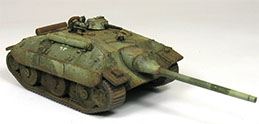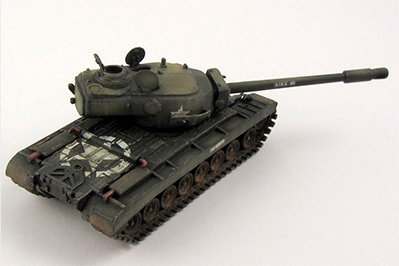Menu
| |
15mm Europe '46-'49

A Soviet IS-4 knocked out by an M34 Taylor
at the Second Battle of Puławy, April 1949
When Hitler suffered a seizure and slipped into a coma in the late planning stages of Operation Wacht Am Rhein, a power struggle ensued between Himmler and Göring and the German General Staff immediately intervened, staging a coup and purging the Nazi high command. The great offensive, delayed until the end of December 1944 as a result, was conducted as a spoiling attack, inflicting maximum damage whilst conserving resources, which stunned the Americans and British and set their plans back for months. Taking advantage of the lull, the Germans switched their forces to the East, delivering similar carefully-planned blows to the Soviet Armies in East Prussia and Hungary. In the meantime, the German war machine turned out increasing numbers of the superweapons Hitler, now dead, had dreamed would bolster the Third Reich's fortunes.
These severe setbacks made the always-fragile alliance between the Western Allies and the Soviet Union untenable, and the alliance collapsed in the midst of mutual recriminations. No longer saddled with Hitler's incompetant leadership, the Germans continued to fight tenaciously for every inch of territory. Despite this, the greatly superior material resources of the now disunited anti-Nazi forces continued to tell, gradually grinding down the Reich into early 1946, until in April of that year Soviet troops, coming into contact with British forces, fired on them in what was clearly purposeful aggression. Seeing this as the shape of things to come, the Allies decided to settle with the Germans and bring their forces to bear against Stalin's legions. The German generals, still eager to fight the Soviets, agreed to a conditional surrender on the condition that they formalise what was until this time a de facto de-Nazification. While this was not the preferred outcome for the leadership of the Western Allies, it permitted them to join forces with the Germans for another drive to the East, their objective -- to clear Eastern Europe of all Soviet armies.
Manufacturer's note: What-if scenarios are increasingly popular with 15mm WWII gamers, as is Weird World War II ("WWWII"), so we're offering some more vehicles for gaming a war that stretches almost to 1950. The Germans fight well into 1946, and then the combined forces of the Western Allies and Germany fight against Soviet domination of Eastern Europe. There are several German "paper panzers" available in 15mm already, so to balance it out we've decided to make Allied vehicles at least to start. When the line is expanded it will feature vehicles that were actually well in development or were actually manufactured, at least for the Allies and Soviets. Decals for insignia shown on the paint-ups are not included.
|
GERMANY

The PzKfw VIII Eisbar (Polar Bear) had been nicknamed the Maus during development. It was the largest turreted tank put into production in the war. Although it required a lot of maintenance to keep servicable, it found a new lease on life as an assault tank on the broad, flat expanses of much of Eastern Europe, where it could dominate the steppes.
The E-25 Fuchs began to be deployed in large numbers in late 1945, its welded plate construction permitting large numbers to be produced relatively cheaply. Lessons were learned from the Hetzer series and the E-25 was considerably larger, both to increase crew comfort and to make room for the large, powerful 75mm PAK42 L70. Intended to be a jagdpanzer, it was too often pressed into service in a tank role, for which the vehicle was not always suited due to its fixed armament, but when properly used, as a tank destroyer, the Fuchs was a deadly opponent.
Historical note: Fuchs is German for fox and is of course a conjectural name. No E-25s were manufactured. A few Maus were made, and I have guessed that it may have been renamed Eisbar if put into serial production, for the largest terrestrial carnivore on earth.
Model built and painted by Heresy Brush.
|
SOVIET UNION

We have several models available for the Russians:
The T-44 was an improvement on the T-34, with a turret similar to the T-34/85 but with a new hull that offered much better cross country performance. Firepower did not quite match that of the American Pershing, but armoured protection was about the same -- a major improvement over the T-34. The tank proved itself greatly superior to the Sherman tanks still in use amongst the Western Allied forces in the tank battles in Poland.
Historical note: The T-44 actually went into mass production, but as the war was ending when the vehicle became available on a widespread basis, the T-34 remained the predominant vehicle produced. However, 2,000 T-44s were manufactured and a handful did fight in the last days of WWII (three against the Germans and several units against the Japanese). After the war there were units deployed in Germany, some of which were used in the suppression of the Hungarian uprising in 1956. If hostilities had continued as contemplated in this alt-history range, the T-44 may well have been given manufacturing precedence.
The IS-4 was manufactured alongside the IS-3 and served as a replacement in IS-2 heavy tank battalions, and was a simple swap out for the IS-2 because it was similar in many ways, although it was heavier and a bit slower than the IS-2. Its heavy armour was proof against most enemy tanks other than the M34 Taylor and the Panzer VIII Eisbar. During the war against the Allies and Germans, the IS-4 was in the forefront of the fighting.
Historical note: The image shows the IS-4 in both configurations -- the earlier one with the tanks on the sides, like a T-34, and the later with the tanks on the rear. Pewter parts for both configurations are included in the set. As a (non-alternative) historical note, this vehicle was actually manufactured and deployed in units, but its weight due to its very thick armour led to a sluggish performance, and Soviet tank design had already begun to focus instead on the jack of all trades Main Battle Tank, such as the T-55, so the units were stationed in the Far East. Had the Allies gone to war with the Soviets, however, the IS-4 would almost certainly have seen more production and involvement in that conflict.
|
UNITED STATES OF AMERICA

With the M26 Pershing Tank coming into American armoured forces in increasing numbers in 1946, that tank became the main American medium tank, with the M4A3E8 Sherman "Easy Eight" and M24 Chaffee filling the role of lighter tanks. Of course, the redoubtable M34 Taylor Superheavy Tank was the main American heavy tank which, along with the British Conqueror and French ARL44, defeated first the German supertanks and then the Soviet heavies such as the IS-4.
Named the "Taylor" by the British after American general and President Zachary Taylor, the M34's breathtakingly powerful 120mm gun proved more than capable of defeating the armour of the Eisbär (the production name of the German vehicle playfully dubbed the Maus while in development) and the IS-4, the most common Soviet heavy tank in the 1947-49 war. Fielded in independent heavy tank battalions by the Americans, French and the Free Poles, this enormous creature was one of the most powerful vehicles in the field in the late 1940s.
The M24 Chaffee was by many measures the best light tank of the war, fast, relatively well-armed, protected and manufactured. These tanks did invaluable service in driving the Soviets out of Eastern Europe, although they struggled when facing the T-34/76, which was increasingly pressed into service by the Soviets as a light tank after hostilities broke out with the Western Allies.
Historical note: M34 Taylor is the conjectural name we have given the T34 superheavy tank that was actually manufactured and tested in small numbers (two) by the US Army at the end of, and after, WWII. (It was later further developed as the M103 heavy tank.) American tanks in development were generally given "T" designations, converted over to "M" once the vehicle went into production, so we feel that the designation "M34" is not unreasonable (and of course we could not market it as a "T34!"). The name "Taylor" is pure fancy, but not completely outside the realm of possibility. Had WWII been extended it's quite possible that the T34 would have been put in production and restyled M34, hence this model. It is a mix of resin and pewter, and comes with rare earth magnets to keep the turret on -- the pewter cannon barrel is so huge and heavy the turret won't remain on otherwise! (Of course it may be glued on.) The three turret hatches are all separate and may be posed open or closed.
Model built and painted by Troop of Shewe.
|
|

